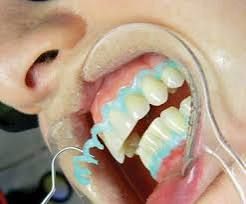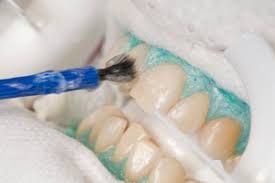Hi everyone out there, on this post we shall discuss on types of bleaching one after the other. As we know that bleaching could either be used for vital or non-vital tooth.
So for this post, we would start with vital tooth bleaching which are as follows;
A vital tooth could be bleached by either of the following clinical procedures which are;
(i) In-office Bleaching or Power Bleaching
(ii) Night Guard Bleaching Technique
(iii) Assisted Bleaching Technique
(iv) Microabrasion or Abrosion
As for this post we would discuss on POWER BLEACHING which is one of the prominent and important bleaching process.
POWER BLEACHING
Power bleaching is a tooth whitening procedure carried out in the dental clinic by 30-35% concentrated Hydrogen peroxide solution which is activated by heat, chemical or even intense light.
"Power bleaching or professional in-office bleaching is a term used to describe the treatment of discolored dentition with high-concentration oxidizing agents by the dentist chairside."Source
This bleaching procedure due to its high concentration requires that the soft tissue which includes the gingiva and the oral mucosa be covered in order to prevent burning sensation or even trauma.
Soft tissues could be covered with rubber dam isolation or light cure resin shield in order to prevent tissue damage.
The duration of appointment could be 2-6 times each appointment done once in a week and each visit lasts within the range 30-45 minutes or at times could extend to 60 minutes (a hour) depending on the case available.
1- Hypersensitivity is a common side effects of bleaching in nearly 50% of cases.
2- Likewise, another side effect is change in the colour of composite restoration when in contact with bleaching agents especially H2O2 reagent.
3- Amalgam restorative materials also release mercury(Hg) when in contact with bleaching agents especially concentrated H2O2.
4- Pulpal enzymes have been said by some authors to be inhibited by concentrated H2O2 solution.
5- Periapical periodontitis have been mostly reported to a common side effect of vital tooth bleaching.
Note:
For effective and significant bleaching procedure the following needs to be agreed the maxillary arch should be treated and bleached accordingly and avoid treating as the same.
Last but not least for this procedure is the avoidance of using local anesthesia during or before bleaching as this would lead failure of communication between the dentist 🦷🦷🦷🦷 and the patient, as the patient won't be able to feel any pain, burning sensation or even injury to the soft tissue which could serve as a caution to dental practitioners when involved in bleaching procedure.
That's all as regards this post. More would be greatly discussed on the bleaching
Happy Blogging and Reading
Video from Teeth Talk Girl YouTuber




Telegram and Whatsapp